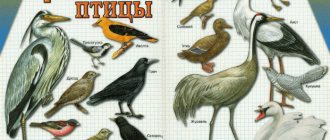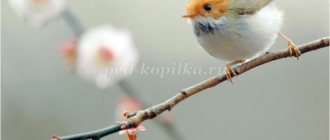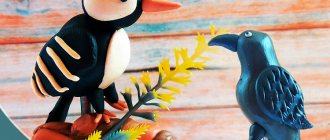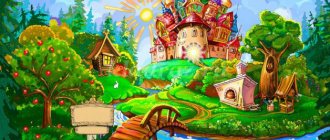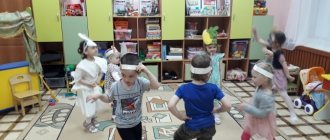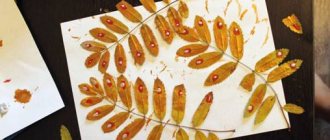Planning
One of the tasks facing a teacher who plans to prepare a chosen topic is to enrich the vocabulary of the children being taught and to actively use the vocabulary of the lesson. In this regard, in daily conversations it is important to use terms, concepts and discuss issues that are directly related to the topic:
Birdhouse
- “migratory birds”, “wintering”, “waterfowl”, “flying for the winter”, “birdhouse”, “nest”, “hatching eggs”, “breeding offspring”;
- swans, ducks, rooks, swallows, storks, starlings, larks;
- where birds live, how they breed, what the growing chicks eat;
- winter is a difficult period in the life of birds; How can people support birds?
The culmination of the work done should be a memorable event, during which the children will be able to take advantage of the acquired knowledge. As a final touch, a thematic quiz, exhibition of crafts or drawings on a given topic is suitable. Parents' participation in the creative process always enhances children's understanding of the significance of the event. What will be truly memorable will be the hanging of feeders on the site, created with the help of the mothers and fathers of the pupils.
Drawing
Mini-project of thematic work
To develop and maintain interest in the proposed topic during the thematic week, it is desirable to create in children additional emotions and experiences that can turn abstract-sounding concepts into more realistic ones.
Interesting! Listening and discussing literary works, dramatization and watching videos and animated materials dedicated to the life of a flock of birds will help the child become more imbued with the desire to help birds and love wildlife.
Calendar plan senior group: on the topic “Migratory birds”
Morning exercises.D/I with pictures “Migratory birds” Purpose: To teach children to classify birds, find familiar migratory birds in pictures, name them, use generalizing words “migratory”, “wintering” birds in speech.
Educational story “Which birds are the first to fly to warm lands?” Goal: To expand children’s understanding of migratory birds, to introduce children to the concepts of “insectivorous” and “granivorous” birds. Bring children to general conclusions about why these birds are the first to leave their native lands.
Canteen duty. Assignment of duty officers: Dasha, David. Goal: To teach children to set the table correctly and accurately, to encourage the desire to finish what they have started. Cultivate responsibility, accuracy, and hard work.
P/U “Table Behavior” Purpose: To develop children’s cognitive skills and self-service skills, teach them to observe basic rules of etiquette, and exercise self-control.
Individual work on visual arts with Goal: to train children in the ability to hold scissors correctly and operate with them, learn to cut a square diagonally, compose and paste an image of flying birds from triangles.
P/U “Fast, dexterous, skillful” Purpose: To strengthen children’s ability to quickly and independently dress in a certain sequence, and, if necessary, politely ask an adult for help
Educational story “Birds of Migratory” Purpose: Invite children to tell what birds they often see during a walk, to remember the names of birds that they have not seen for a long time. Tell the children why some birds stay in our area for the winter, while others fly away.
P/I “Sparrows and the Cat” Purpose: Invite children to tell the rules of the game, answering the teacher’s questions, to develop children’s ability to act on a signal.
D/I “What if there’s a lot?” (on the topic of the week) Goal: To teach children to form the plural of verbs.
Labor assignments: collecting fallen leaves for crafts. Goal: To teach children to distinguish tree leaves and compare them according to different characteristics.
Formation of CGN and self-service skills. P/U: “Where and how are our things.” Goal: Continue to teach children to carefully fold and hang their clothes in a stall, and put their shoes in a bag. Cultivate the habit of doing this daily.
A conversation about the benefits of daytime sleep. Reading x/l: S. Kozlov “Geese”.
Evening:
Invigorating gymnastics, walking on massage mats and “health” paths
Develop children’s ability to dress independently after sleep and carefully make their bed; cultivate perseverance.
Dining room duty Purpose: To teach children to assist in setting the table. To stimulate the desire to responsibly perform the duties of an attendant, to cultivate diligence.
Didactic game: “Eagle” (on the topic of the week) Purpose: To teach children to correctly use the prepositions “under” and “above” in speech.
The game is a dramatization based on the fairy tale by G.Kh. Andersen's "The Ugly Duckling" Purpose: To teach children to independently assign roles, convey the characters' personalities and the emotions they experience. Help increase the expressiveness of speech, facial expressions, movements, encourage the desire to try yourself in different roles.
Work assignments: washing toys. Goal: To form in children a conscious desire for order. Improve labor skills related to washing toys and their placement. Foster hard work and responsibility.
Individual drawing work with Sasha, Dasha, Vova. Goal: To train children in coloring an image with a pencil without going beyond the outline. Record the names of migratory birds.
Observation “Birch in golden decoration” Purpose: To expand children’s understanding of the diversity of trees, to teach them to distinguish them by appearance. Pay attention to the characteristic signs of birch.
P/I “Migration of Birds” Purpose: To acquaint children with the rules of the game, develop the ability to move easily, and act on the teacher’s signal.
D\I “Guess what” (on the topic of the week) Purpose: To teach children to use nouns in the instrumental case in speech.
Long-term event planning table
To achieve the greatest effect from a short-term (1 week) project, it makes sense to draw up a calendar plan, taking into account natural circumstances - the readiness of birds to fly to warmer climes (in autumn) or arrive after wintering (in spring). On spring days, the folk calendar also contains dates and events, the symbols of which are certain breeds of birds. Folk traditions foster respect for the history of their people, the ability to appreciate the cultural heritage of their native land and maintain the connection between times.
Entertaining mathematics in games for preschoolers
| Time of year (the exact month is determined depending on the climatic characteristics of the region and the folk calendar) | Observations and actions carried out on the street during a walk | Activities in addition to daily themed classes. |
| Autumn (late September, October, early November) |
|
|
| Spring (late February, March, early April) |
|
|
ECD on the topic “Migratory Birds” in the senior group
If the theme of the week is “Migratory Birds,” the senior group should conduct a variety of activities that foster a love and interest in wildlife. Children will be happy to take part in making delicious treats for their feathered friends.
To conduct the lesson, you will need the following products, agreed upon in advance with parents and brought by the children from home:
- Butter or melted lard (lard);
- Pumpkin and sunflower seeds;
- Dried berries.
Seeds, berries and lard are mixed in a large container. Children fold pre-prepared ropes 35-40 cm long in half. The rope should be placed in the center of the balls formed by the children from the resulting mixture. The finished delicacy is hung on the branches of trees growing on the site.
Origami classes
The origami technique develops accuracy, precision of movements and eye.
Interesting! Children who have the ability to fold, especially small paper miniatures, have a chance in the future to master professions that require developed hand motor skills.
Outline diagram Duck
Application
For an application on the theme “Birds” in the senior group, the teacher chooses the technique at his own discretion, taking into account the requirements of the Federal State Educational Standard.
Drawing lessons by design for middle and senior kindergarten groups
To conduct the lesson, you will need a pre-prepared template depicting the outline of a bird. Children, having transferred the image onto a thick sheet of paper or cardboard, can
- fill the outline with pieces of colored paper using the mosaic technique;
- perform applique by placing cut-out parts on top of each other, using multi-colored paper for different parts of the body
- make stained glass applications from colored tracing paper; The application “migratory birds” is also suitable for the preparatory group
Stained glass
Planning a thematic week “Birds of Migratory”
When planning the theme of the week “Birds of Migratory” in the preparatory group, the goal is to conduct daily lessons on one topic. Classes are held in a variety of formats, which helps preschoolers maintain interest in the topic throughout the week.
Children learning about birds is good for their overall development
Target
The purpose of the thematic week “Birds of Migratory” is:
- preschoolers gain new knowledge about animals;
- systematization of existing ones;
- the formation of a sustainable interest in the nature of the native land;
- ability to distinguish between different species;
- developing an understanding of the importance of animals in nature.
Lexical topic
The lexical topic “Migratory Birds” pursues the following goals:
- expand children's vocabulary;
- repeat words already familiar to children;
- formulate sentences correctly when composing a story.
Note! To achieve these goals, the teacher gives children tasks from the vocabulary section “Add!” The teacher reads short poems about migratory birds in which the last word is missing. Kids must fill in the missing words in the rhyme.
Thematic vocabulary is replenished with the following words:
- rook;
- swift;
- martin;
- crane;
- stork;
- wagtail;
- cuckoo;
- starling;
- heron;
- swans;
- lark;
- goose;
- fluff;
- feathers;
- wedge;
- flight;
- birdhouse;
- nest;
- insects;
- insect larvae;
- seeds;
- songbirds;
- twist;
- bring out;
- hatch;
- eggs;
- feed;
- peck;
- fly away;
- spring;
- spend the winter.
Book reading is required
Final event
It is recommended that the final event in the preparatory group be held in the form of a quiz. The group is divided into two or more teams with a captain. Each receives assignments on the topic “Migratory Birds”. Each task is assessed using a point system and the winner is determined based on the results.
Mini project
One week is given to prepare the mini-project (step-by-step preparation method). Children prepare it together with their parents at home. Each pupil and parent receives the name of a migratory bird on which he must collect information:
- Photo on removable media to display on a media board using a projector.
- Description of appearance.
- Habitat.
- Time to return to Russia and fly to winter quarters.
- Nutritional features.
Innovative technologies in education according to the Federal State Educational Standard
After preparing the project, each child defends it in front of the group. This final lesson gives preschoolers the opportunity not only to prepare information on their own, but also gives them experience in public speaking and helps overcome shyness and fear of an audience.
Interesting! The senior group can also participate in the mini-project.
